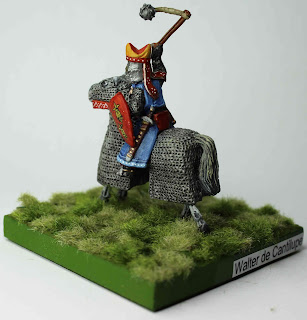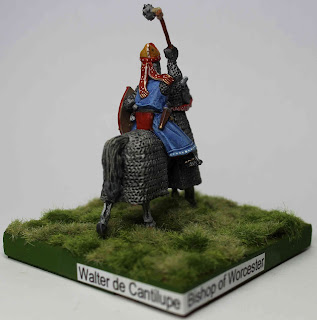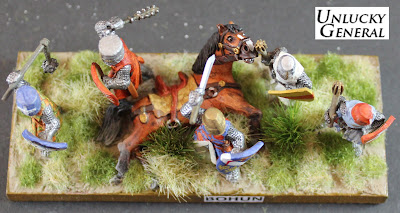Walter de Cantilupe: Bishop of Worcester
Walter de Cantilupe, Bishop of Worcester was the leading ecclesiastical proponent of the attempts at church and governmental reform. Walter took de Montfort's part in rebellion during the second Barons War, taking the lead role as advocate from his high-minded and reforming mentor Robert Grosseteste, the former Bishop of Lincoln. The two churchmen had been at Oxford together in the 1220s, Walter was attaining his Master's Degree and Robert lectured there.
Formerly a clerk of the King's exchequer by 1215 and a one time justice, be entered holy orders and received consecration as Bishop of Worcester in 1237. Between 1208 and 1236 Walter had held a total of thirteen benefices and ecclesiastical offices at one time or another but had not been consecrated until after his attainmet of his Bishopric. Some of these 'estates' had been royal but others were hereditary including Brailes at Kenilworth.
Moving from courtier to rebel, Walter became opposed to Papal policy and the political alliance between Rome and an unrelenting crown. He was both a champion of a nationally identifying clergy and religious reform, holding a synod in Worcester Cathedral (1240) which introduced rules governing Godparents, rest on holy days and disallowed the clergy from activities such as the playing of chess.
By 1254, through the untimely deaths of his brother William and in turn William's eldest son, Walter became head of the family whilst his nephew George was a minor.
By 1258, Walter became one of the Twenty Four committee members through the Provisions of Oxford and was a key baronial representative. He was at Lewes and blessed the army prior to the battle. Afterwards, he appears to have taken a back seat to affairs under de Montfort's government and was not a member of the Council of Nine - which included instead, Stephen Bersted, Bishop of Chichester. Walter was also at Evesham where heard Earl Simon's confession - his last. Walter avoided the consequent papal excommunication which his fellow reforming clergymen experienced, dying in February 1266.
Above is a contemporary image of Thomas de Cantiplupe (sainted Bishop of Hereford) whom I took the colours from for my miniature. Whilst not Walter and of another bishopric, modern ecclesiastical apparel (including the mitre) of the Bishop of Worcester often has the same colour scheme including the mitre of yellow with red bands. Imagery throughout is not consistent with the above white mitre in the heraldic device for Worcester.
The above tomb and effigy is attributed to Walter de Cantilupe in Worcester Cathedral.
Formerly a clerk of the King's exchequer by 1215 and a one time justice, be entered holy orders and received consecration as Bishop of Worcester in 1237. Between 1208 and 1236 Walter had held a total of thirteen benefices and ecclesiastical offices at one time or another but had not been consecrated until after his attainmet of his Bishopric. Some of these 'estates' had been royal but others were hereditary including Brailes at Kenilworth.
Moving from courtier to rebel, Walter became opposed to Papal policy and the political alliance between Rome and an unrelenting crown. He was both a champion of a nationally identifying clergy and religious reform, holding a synod in Worcester Cathedral (1240) which introduced rules governing Godparents, rest on holy days and disallowed the clergy from activities such as the playing of chess.
By 1254, through the untimely deaths of his brother William and in turn William's eldest son, Walter became head of the family whilst his nephew George was a minor.
By 1258, Walter became one of the Twenty Four committee members through the Provisions of Oxford and was a key baronial representative. He was at Lewes and blessed the army prior to the battle. Afterwards, he appears to have taken a back seat to affairs under de Montfort's government and was not a member of the Council of Nine - which included instead, Stephen Bersted, Bishop of Chichester. Walter was also at Evesham where heard Earl Simon's confession - his last. Walter avoided the consequent papal excommunication which his fellow reforming clergymen experienced, dying in February 1266.
Whilst I am unable to ascertain Walter de Cantilupe's age at Lewes he cannot have been a young man. I hazard that he was at least 15 when taking up a clerkship (could have been older) he must have been in his 60s at Lewes. He was nevertheless the head of his family and a family of the knightly class. Given his presence at the Battle I am including him as one of my two bishops, fully armoured and taking the field. He may not have been a fighting bishop in the fullest sense but I imagine him taking the field all the same; fully protected and leading his flock whom he deemed a crusading force like the good sheppard, invoking the spirit and blessing of Saint Thomas a Becket.
I have two choices with Bishops when it comes to their heraldry. I can either go with the ecclesiastical heraldry which I have done for my Bishop of London, or I can go with the office holder's own family blazon which I have done for Walter de Cantilupe. Given his status as head of the family by the time of the battle, it seemed more appropriate. In the above image there are all recorded bearings for those who held the Bishopric of Worcester including Walter's (top row, fifth from the left) and the Bishopric heraldry in the centre. Walter de Cantilupe's blazon is gules, three leopards' faces jessant-de-leys or reversed (below). The above tomb and effigy is attributed to Walter de Cantilupe in Worcester Cathedral.











Comments
Just finished more scots, will post this weekend
Cheers
Matt